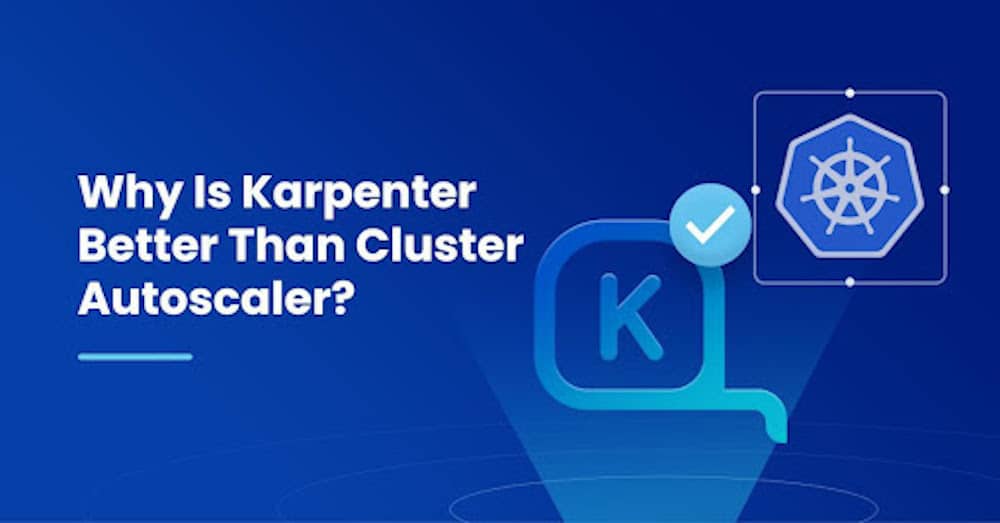In the realm of Kubernetes cluster management, two prominent tools have emerged: Karpenter and Cluster Autoscaler. While both serve the purpose of optimizing resource allocation, Karpenter has proven to be a superior choice for scaling and managing clusters efficiently. This blog post aims to explore the key reasons why Karpenter outshines Cluster Autoscaler and why it has gained significant popularity among Kubernetes users.
What is Karpenter?
Karpenter is an open-source Kubernetes add-on focusing on cluster autoscaling and node allocation. It is designed to enhance the efficiency and resource allocation capabilities of Kubernetes clusters. Karpenter leverages advanced algorithms, machine learning techniques, and intelligent scaling mechanisms to optimize resource allocation and ensure optimal performance.
Karpenter extends the functionality of Kubernetes by providing advanced scaling and node allocation strategies. It analyzes historical data, workload patterns, and resource usage trends to make informed scaling and node allocation decisions. By considering various factors, such as application requirements and resource usage, Karpenter can accurately predict workload demands and scale clusters accordingly.
What Is Cluster Autoscaler?
The primary goal of Cluster Autoscaler is to ensure that the cluster has enough capacity to handle the workload while preventing over-provisioning or underutilization of resources.
When a Kubernetes cluster is running out of resources, such as CPU or memory, Cluster Autoscaler automatically adds additional nodes to the cluster to meet the increased demand. Similarly, when the workload decreases, and there are idle or underutilized nodes, Cluster Autoscaler scales down the cluster by removing the unnecessary nodes, thus saving costs and optimizing resource allocation.
Cluster Autoscaler works by monitoring the resource usage of pods within the cluster and comparing it to the available capacity. It utilizes metrics such as CPU utilization, memory usage, and custom-defined metrics to determine when scaling actions are necessary. The tool continuously evaluates the cluster’s resource state and makes scaling decisions based on predefined rules and policies.
Why Is Karpenter Better Than Cluster Autoscaler?
- Intelligent and Advanced Scaling Mechanism:
One of the primary differentiators of Karpenter is its intelligent and advanced scaling mechanism. While Cluster Autoscaler focuses primarily on scaling nodes based on CPU and memory utilization, Karpenter takes a more holistic approach. Karpenter leverages advanced algorithms and machine learning techniques to predict workload demands accurately. It considers various factors such as historical usage patterns, application requirements, and resource usage trends to make informed scaling decisions.
By analyzing historical data and trends, Karpenter can anticipate resource needs in advance, ensuring optimal scaling without unnecessary overhead. This intelligent scaling mechanism helps prevent resource shortages and enables organizations to achieve cost-efficiency while maintaining high availability.
- Enhanced Node Allocation Strategies
Another area where Karpenter shines is its enhanced node allocation strategies. Cluster Autoscaler has a relatively simplistic approach to node allocation, often resulting in suboptimal resource utilization. In contrast, Karpenter provides advanced node allocation strategies that go beyond just balancing the workload.
Karpenter utilizes bin-packing algorithms to allocate pods intelligently across nodes, optimizing resource usage and minimizing waste. By intelligently packing pods, Karpenter can significantly reduce the number of nodes required to run a given workload, leading to substantial cost savings. This feature is handy for organizations with variable workloads that experience fluctuating resource demands.
- Seamless Integration with Kubernetes Ecosystem :
Karpenter has been designed with seamless integration into the Kubernetes ecosystem in mind. It seamlessly integrates with other popular Kubernetes tools, such as Horizontal Pod Autoscaler (HPA) and Custom Metrics APIs. This integration enables Karpenter to leverage the rich set of metrics these tools provide for more accurate scaling decisions.
Furthermore, Karpenter extends Kubernetes’ declarative nature, allowing users to define scaling policies through Kubernetes manifests. This approach simplifies cluster management and makes it easier to adopt Karpenter without significant changes to existing workflows.
- Improved Cluster Stability and Resource Efficiency:
With its advanced scaling mechanisms and intelligent node allocation strategies, Karpenter offers improved cluster stability and resource efficiency compared to Cluster Autoscaler. By accurately predicting workload demands and optimizing resource allocation, Karpenter ensures that clusters are neither underutilized nor overloaded.
The enhanced resource efficiency provided by Karpenter leads to reduced infrastructure costs and better utilization of existing resources. Additionally, Karpenter helps maintain cluster stability by preventing resource shortages and reducing the chances of service disruptions due to insufficient capacity.
Conclusion
Karpenter is the superior choice over Cluster Autoscaler due to its intelligent and advanced scaling mechanism, enhanced node allocation strategies, seamless Kubernetes ecosystem integration, and improved cluster stability and resource efficiency. By harnessing the power of machine learning and advanced algorithms, Karpenter empowers organizations to optimize their Kubernetes clusters, reduce costs, and deliver better performance. As Kubernetes adoption grows, Karpenter stands out as a valuable tool for managing and scaling clusters effectively.


